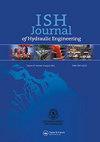利用沉叶研究河流泥沙偏转的研究进展
引用次数: 4
摘要
导流或偏转沉积物是河流治理的重要组成部分。在诱导螺旋运动的作用下,水下叶片最著名的作用是使沉积物偏转。本研究介绍了目前使用水下叶片进行沉积物偏转的最新信息,以及概述当前知识的局限性和对未来使用水下叶片进行沉积物偏转研究的建议的结论性说明。首先介绍了沉水叶片运行的基本物理分析背景。然后,论文移动到叶片设计参数基于分析关系的彻底检查。本文还简要介绍了浸没式叶片的应用。为此目的,对最近的研究进行了回顾,目的是设计一种淹没叶片的布局,以协助河流训练任务,例如保护河流弯曲、在取水口排除沉积物、改善水道桥梁的安全、改善内陆航行。研究还提出了今后在辫状河中用于改善内河航行的沉水叶片的研究方案。文献中的主要滞后是缺乏关于宏观湍流和由水下叶片尾迹引起的相关泥沙运动的信息。本文章由计算机程序翻译,如有差异,请以英文原文为准。
A review of sediment deflection in rivers using submerged vanes
ABSTRACT Diverting or deflecting sediments is an essential part of river training. Under the effect of an induced helical motion, the submerged vanes are best known for deflecting sediments. This study presents current state-of-the-art information on employing submerged vanes for sediment deflection, as well as concluding notes outlining the current knowledge’s limitations and suggestions for future research on sediment deflection using submerged vanes. The analytical background for basic physics of submerged vanes’ operation is first described. The paper then moves on to a thorough examination of vane design parameters based on analytical relationships. A brief overview of the applications of submerged vanes is also included in the paper. A review of recent studies aims at designing a layout of submerged vanes to assist in river training tasks, such as river bends protection, sediment exclusion at water intakes, improving safety at bridges on waterways, improving inland navigation is provided to this end. The study also presented a future program of research on submerged vanes for improving inland navigation in braided rivers. The major lag in literature is a lack of information on macro turbulence and the associated sediment motion induced by the wake of the submerged vane.
求助全文
通过发布文献求助,成功后即可免费获取论文全文。
去求助
来源期刊

ISH Journal of Hydraulic Engineering
Engineering-Civil and Structural Engineering
CiteScore
4.30
自引率
0.00%
发文量
59
 求助内容:
求助内容: 应助结果提醒方式:
应助结果提醒方式:


